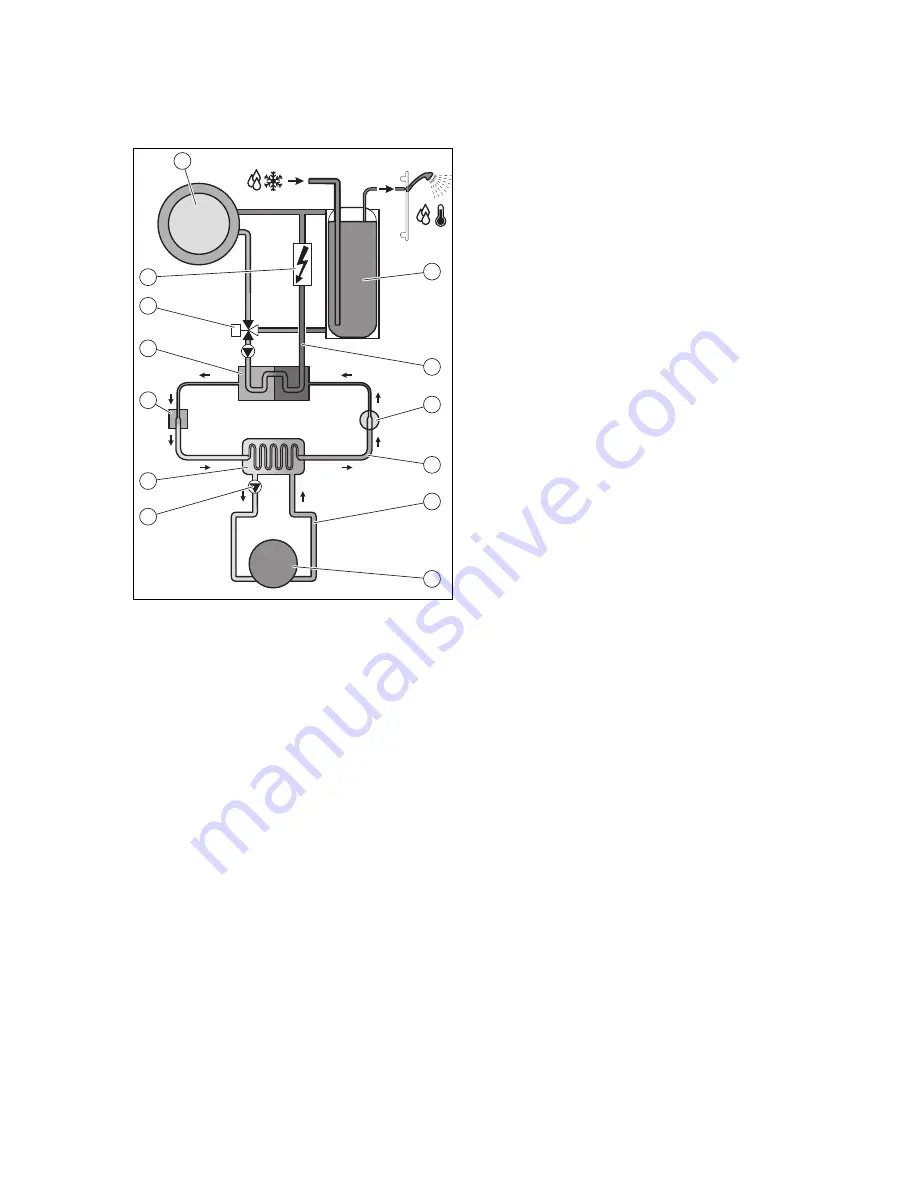
3 System overview
8
Installation and maintenance instructions flexoTHERM exclusive 0020213395_00
3.2
Functionality
3.2.1
Heat pump
2
3
1
4
5
6
7
8
9
10
11
12
13
1
Heating installation
2
Domestic hot water
cylinder (optional)
3
Heating circuit
4
Compressor
5
Refrigeration circuit
6
Brine circuit
7
Heat source
8
Brine pump
9
Evaporator
10
Electronic expansion
valve
11
Condenser
12
Heating/cylinder char-
ging diverter valve
13
Auxiliary electric heating
The heat pump system uses geothermal energy or ground-
water as the heat source.
The heat pump consists of the following separate circuits
which are coupled with one another by means of heat ex-
changers. These circuits are:
–
The brine circuit, which extracts the thermal energy from
the ground or the groundwater and transfers it to the refri-
geration circuit
–
The refrigerant circuit, which is used to bring the thermal
energy from the heat source to a usable, higher temper-
ature level and deliver it to the heating circuit
–
The heating circuit, which is used to heat up the living
rooms
The coolant circuit is connected via the evaporator to the
heat source, from which it extracts thermal energy. At the
same time, the physical state of the coolant changes; it
evaporates. The refrigerant circuit is connected via the
condenser to the heating installation, to which it releases the
thermal energy again. In so doing, the coolant becomes
liquid again; it condenses.
As thermal energy can only pass from a body at a higher
temperature to a body at a lower temperature, the coolant in
the evaporator must have a lower temperature than the heat
source. On the other hand, the temperature of the coolant in
the condenser must be higher than that of the heating water
in order to be able to release the thermal energy to it.
These different temperatures are produced in the coolant
circuit by means of a compressor and an expansion valve,
which are located between the evaporator and condenser.
The coolant flows in vapour form from the evaporator into the
compressor, where it is compressed. This causes the pres-
sure and temperature of the coolant vapour to rise sharply.
After this process, it flows through the condenser, where it
releases its thermal energy to the heating water by condens-
ation. It flows as a liquid into the expansion valve, where
it expands significantly and, in so doing, loses much of its
pressure and temperature. This temperature is now lower
than that of the brine that flows through the evaporator. The
coolant can thus absorb more thermal energy in the evap-
orator, turning into vapour in the process and flowing to the
compressor. The cycle starts again.
The evaporator and parts of the refrigerant circuit inside the
heat pump are cold-insulated, meaning that no condensate
can accumulate. Any small amounts of condensate which
may form evaporate as a result of the heat generated inside
the heat pump.
The product is equipped with an active cooling function
that you can use to maintain the temperature of your living
rooms when the outside temperature is high during summer.
Ground and groundwater are particularly good heat sources
for this use. For this purpose, a 4-way diverter valve is
integrated into the heat pump's refrigerant circuit. This uses
the principle of active cooling, in which the refrigerant circuit
is used to extract thermal energy from the heat recovery
system (e.g. the underfloor heating) in order to deliver this to
the heat source. For this, the 4-way diverter valve is used
to hydraulically swap the heat exchange processes in the
evaporator and condenser in the refrigerant circuit.
The heating water, which, when supplied, is colder in the
flow than the room temperature, absorbs thermal energy
from the rooms and is pumped by the heating pump to the
condenser (which works as an evaporator when in cooling
mode). This thermal energy is absorbed by the coolant and
heated to a higher temperature level using the compressor.
The thermal energy is then delivered to the brine in the evap-
orator (which works as a condenser when in cooling mode).
The cooled coolant is guided to the expansion valve to en-
able thermal energy to be absorbed from the condenser
again. The brine pump transports the hot brine into the earth,
where the thermal energy is dissipated.
During the installation, it may be useful to exclude some
rooms (e.g. the bathroom) from the cooling function and to
actuate stop valves especially for this. The heat pump elec-
tronics system emits a signal that can be used for actuating
these.
A passive cooling module is also available as an alternative,
whereby thermal energy is transported via underfloor heat-
ing, for example, from the rooms to the ground without the
compressor operating and therefore without the refrigerant
circuit operating.
If required, the integrated auxiliary electric heating can be
activated at different output levels via the heat pump display.
The auxiliary electric heating is then actuated by the system
controller.









































